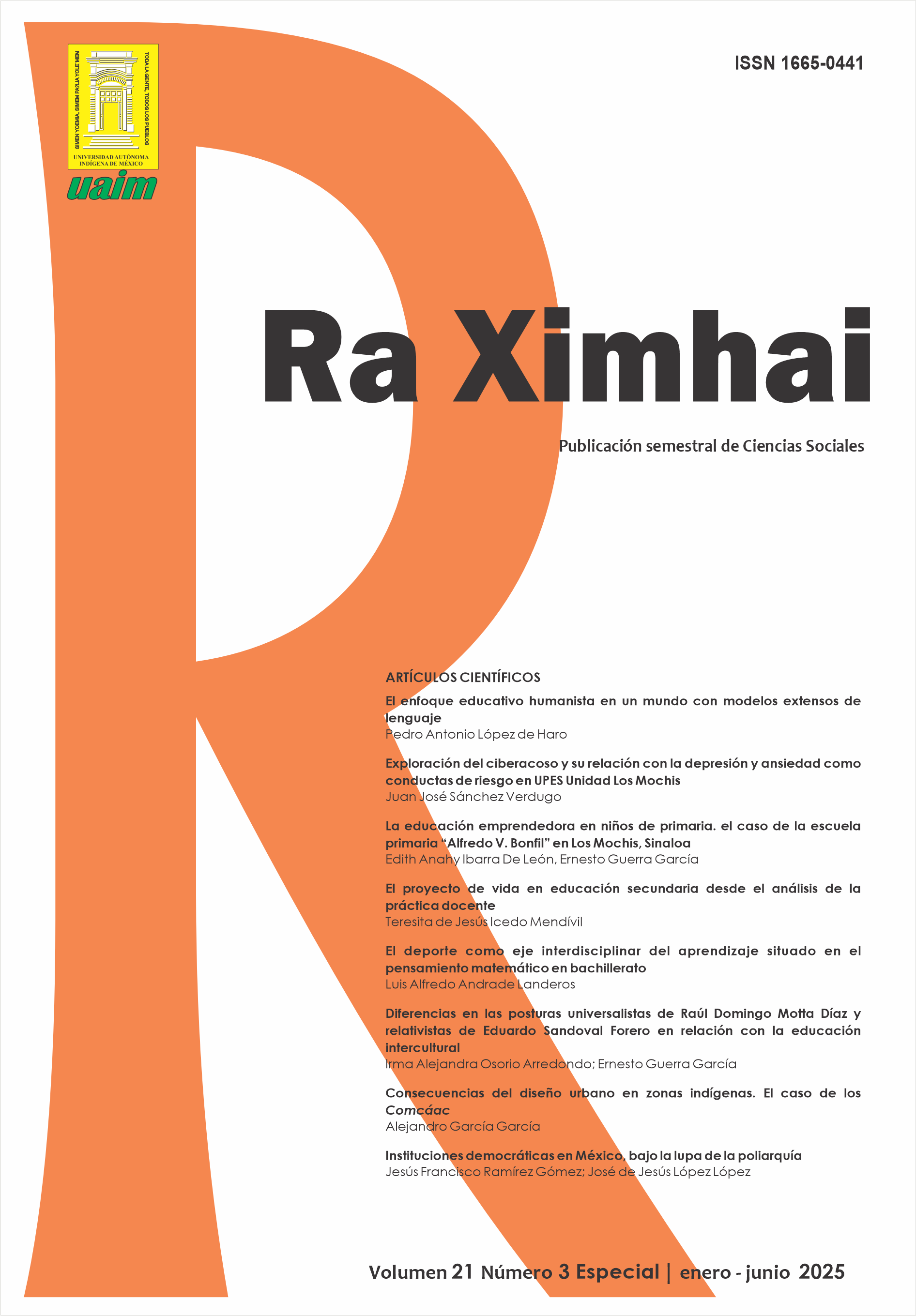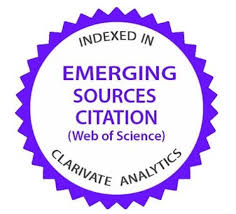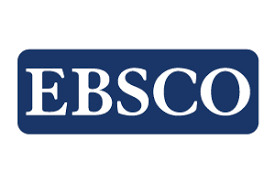Exploration of cyberbullying and its relationship with depression and anxiety as risk behaviors in UPES, Los Mochis campus
DOI:
https://doi.org/10.35197/rx.15.05.2025.02.jsKeywords:
cyberbullying, mental health, academic performance, depression and anxiety, risk behaviorsAbstract
This research examines the relationship between cyberbullying and its impact on mental health and academic performance among students at the Pedagogical University of the State of Sinaloa (UPES), Los Mochis campus. We aim to understand how cyberbullying in virtual environments, contributes to anxiety, depression, and stress, as well as its effects on academic performance.
A survey (single format) was administered to 100 students, as well 5 unstructured interviews with previously identified volunteer students who had experienced cyberbullying and exhibited symptoms of anxiety and depression. Additionally, 20 structured interviews were conducted with faculty members from the institution to assess the prevalence of cyberbullying and its emotional and academic consequences. The findings indicate that 58% of students have experienced cyberbullying, with the majority of them reporting symptoms of anxiety and depression. Furthermore, gender differences were identified in the emotional impact of cyberbullying, with female students being more affected.
Academically, cyberbullying leads to distraction, lack of motivation, and absenteeism, negatively impacting students’ performance. About 45% of respondents reported that anxiety prevents them from concentrating, while 35% mentioned missing classes due to stress.
The study concludes that there is a significant correlation between cyberbullying and emotional and academic problems. We recommend implementing psychological support programs, awareness workshops, and institutional policies to create a safe environment. Lastly, we highlight the importance of ongoing research to assess the effectiveness of these interventions and refine prevention strategies.
Downloads
References
Ayas, T., y Horzum, MB (2011). Exploring the Teachers’ cyber bullying perception in terms of various variables. International Online Journal of Educational Sciences, 3 (2). Recovered from: https://www.ajindex.com/dosyalar/makale/acarindex-1423904389.pdf
Beran T, 2006, A construct validity study of bullying. Alberta Journal of Educational Research, 52(4), 238–47. Recovered from: https://journalhosting.ucalgary.ca/index.php/ajer/article/view/55171
Braun, V., & Clarke, V. (2006). Using thematic analysis in psychology. Qualitative Research in Psychology, 3(2), 77-101.
Cadena Simbaña, A. J., & Puruncajas Llumiquinga, D. C. (2024). Investigación de los problemas psicológicos que provoca el acoso sexual en redes sociales y cómo prevenirlo en jóvenes de 18 a 25 años del barrio Obrero Independiente (Tesis de licenciatura). Recuperado de:
https://dspace.ups.edu.ec/bitstream/123456789/26939/1/TTQ1396.pdf
Criollo Romero, Y. K. (2025). Niveles de depresión y apoyo social en estudiantes de bachillerato de la Unidad Educativa Remigio Romero y Cordero en el período lectivo 2024–2025. Universidad de Cuenca. Recuperado de: https://dspace.ucuenca.edu.ec/items/4fe8c674-7060-47a3-95e1-3f3b5f7cbccf
Bauman, S. (2013). Cyberbullying: What counselors need to know. American Counseling Association.
Escobar Callejas, P. H., & Bilbao Ramírez, J. L. (2020). Investigación y educación superior. Universidad Metropolitana.
ENDUTIH. (25 de abril de 2019). La Encuesta Nacional sobre Disponibilidad y Uso de TIC en Hogares (ENDUTIH) 2018. El Economista.
Erdur-Baker, Ö., & Kavsut, F. (2007). Cyberbullying: A new face of peer bullying. Eurasian Journal of Educational Research, 27, 31-42.
Hinduja, S., & Patchin, J. W. (2008). Cyberbullying: An exploratory analysis of factors related to offending and victimization. Deviant Behavior, 29(2), 129-156.
Instituto Federal de Telecomunicaciones. (2019). Uso de las tic y actividades por internet en México: impacto de las características sociodemográficas de la población (versión 2019). Instituto Federal de Telecomunicaciones. Recuperado de http://www.ift.org.mx/sites/default/files/contenidogeneral/estadisticas/usodeinternetenmexico.pdf
Instituto Nacional de la Salud Mental. (2024). Depresión. Departamento de salud y servicios humanos de los estados unidos Institutos Nacionales de la Salud Publicación de NIH Núm. No. 24-MH-8079S. Recuperado de
https://www.nimh.nih.gov/sites/default/files/health/publications/depression/depresion.pdf
Lovibond, PF y Lovibond, SH (1995). Escalas de Depresión, Ansiedad y Estrés (DASS-42) [Registro de base de datos]. APA PsycTests. Recuperado de:
https://psycnet.apa.org/doiLanding?doi=10.1037%2Ft39835-000
Martínez-Monteagudo, M. C., Delgado, B., Inglés, C. J., & García-Fernández, J. M. (2019). Cyberbullying and social anxiety: A latent class analysis among Spanish adolescents. International Journal of Environmental Research and Public Health, 16(3), 419. https://www.mdpi.com/1660-4601/17/2/406
Marles Triana, N., & Vélez Echeverri, V. (2024). Análisis de la relación entre el ciberbullying y el comportamiento agresivo en los estudiantes del grado sexto de la Institución Educativa Aguaclara del municipio de Tuluá Valle del Cauca en el año 2024. Tesis de licenciatura en psicología). Recuperado de: https://repositorio.uceva.edu.co/handle/20.500.12993/4762
Ocampo, R. F., Escobar, S. D. J., Pérez, S., Hernández, P. B. R. S., & Valero, C. Z. V. (2007). Depresión y ansiedad en estudiantes universitarios. Revista electrónica de psicología Iztacála, 10(2), 94-105. Recuperado de:
https://revistas.unam.mx/index.php/repi/article/download/19112/18139%20rel%3D%27nofollow%27/0.
Organización Mundial de la Salud. (2013). Informe sobre la salud mental en el mundo. OMS.
Downloads
Published
How to Cite
Issue
Section
License
Copyright (c) 2025 Juan José Sánchez Verdugo

This work is licensed under a Creative Commons Attribution-NonCommercial 4.0 International License.
Usted es libre de:
- Compartir — copiar y redistribuir el material en cualquier medio o formato
- Adaptar — remezclar, transformar y construir a partir del material
- La licenciante no puede revocar estas libertades en tanto usted siga los términos de la licencia
Bajo los siguientes términos:
- Atribución — Usted debe dar crédito de manera adecuada , brindar un enlace a la licencia, e indicar si se han realizado cambios . Puede hacerlo en cualquier forma razonable, pero no de forma tal que sugiera que usted o su uso tienen el apoyo de la licenciante.
- NoComercial — Usted no puede hacer uso del material con propósitos comerciales .
- No hay restricciones adicionales — No puede aplicar términos legales ni medidas tecnológicas que restrinjan legalmente a otras a hacer cualquier uso permitido por la licencia.








